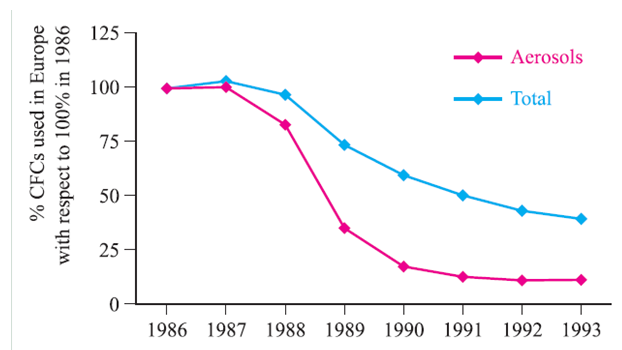


 علم الكيمياء
علم الكيمياء 
 الكيمياء التحليلية
الكيمياء التحليلية 
 الكيمياء الحياتية
الكيمياء الحياتية 
 الكيمياء العضوية
الكيمياء العضوية 
 الكيمياء الفيزيائية
الكيمياء الفيزيائية
 الكيمياء اللاعضوية
الكيمياء اللاعضوية 
 مواضيع اخرى في الكيمياء
مواضيع اخرى في الكيمياء
 الكيمياء الصناعية
الكيمياء الصناعية |
Read More
Date: 21-3-2017
Date: 26-2-2019
Date: 21-1-2018
|
CFCs and the Montreal Protocol
The ozone layer is a stratum in the atmosphere 15–30km above the Earth’s surface, and it protects life on the Earth from UV radiation originating from the Sun because O3 absorbs strongly in the ultraviolet region of the spectrum. An effect of UV radiation on humans is skin cancer. Chlorofluorocarbons (CFCs) are atmospheric pollutants which contribute towards the depletion of the ozone layer. In 1987, the ‘Montreal Protocol for the Protection of the Ozone Layer’ was established and legislation was implemented to phase out the use of CFCs: an almost complete phase-out of CFCs was required by 1996 for industrial nations, with developing nations following this ban by 2010. Taking the 1986 European consumption of CFCs as a standard (100%), the graph opposite illustrates how the usage of these chemicals (e.g. aerosol propellants, refrigerants) was reduced between 1986 and 1993. The phasing out of CFCs has affected the manufacture of asthma inhalers, large numbers of which used to use a CFC-based propellant. These inhalers are being replaced by new models with hydrofluoroalkane (HFA) propellants. CFCs are not the only ozone-depleting chemicals. Other’Class I’ ozone-depleters include CH2ClBr, CBr2F2, CF3Br, CCl4, CHCl3 and CH3Br. In the past, methyl bromide has had widespread agricultural applications for pest control (see Box 16.3). Alternative pesticides for, for example, soil treatment continue to be developed in order to comply with the Montreal Protocol which bans CH3Br by 2005 (2015 in developing countries). As an interim measure, hydrochlorofluorocarbons (HCFCs) can be used in refrigerants in place of CFCs. While less harmful to the environment than CFCs, HCFCs are still ozone-depleting (they are classified as ‘Class II’ ozone-depleters) and will be phased out by 2020. Hydrofluorocarbons appear to have little or no ozonedepleting effect and can also be used in refrigerants and aerosol propellants.

*CFCs : Chlorofluorocarbons



|
|
|
|
تفوقت في الاختبار على الجميع.. فاكهة "خارقة" في عالم التغذية
|
|
|
|
|
|
|
أمين عام أوبك: النفط الخام والغاز الطبيعي "هبة من الله"
|
|
|
|
|
|
|
المجمع العلمي ينظّم ندوة حوارية حول مفهوم العولمة الرقمية في بابل
|
|
|